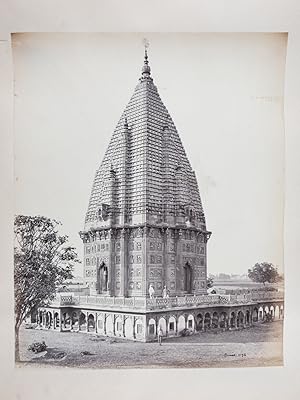Beschreibung
Photographie,vintage albumen print, Photography was a brief but productive parenthesis in the life of Samuel Bourne. Born in Staffordshire in 1834, he initially worked in a bank. But he was also an amateur photographer. He resigned from his post and traveled to India, arriving in Calcutta early in 1863. He attended a meeting at the Photographic Society of Calcutta, then went to Shimla, the governor?s summer residence, having visited and photographed Benares (including the temples and ghats on the banks of the Ganges), Agra (the emperor Akbar?s fort and palace; the Taj Mahal) and Delhi (the Red Fort; Humayun?s tomb; the minaret at Qutb Minar). In Shimla he opened a studio in partnership with William Howard, who had already been in India for some time, and shortly afterward the pair were joined by Charles Shepherd. Following Howard?s departure, the studio took the name ?Bourne & Shepherd?, and a second branch was opened in Calcutta. Shepherd was responsible for the studio portraits, and for the general management of the business. He sold prints of photographs taken by Bourne during his travels. It was in 1864 that Bourne made his longest expedition, which lasted nine months. He went from Chamba to the Chenab valley, then to Srinagar, Kashmir and the north of Punjab, where he took photographs that highlighted his talent for landscape photography, and notably his careful framings and compositions, generally with human figures in the foreground. He returned via Delhi, Cawnpore and Lucknow, where he photographed the key locations of the Sepoy rebellion, which had been put down seven years earlier: La Martiniere, and the Kashmiri and Baillie Guard gates. Bourne?s last major expedition took him to the Himalayas, and the Gangotri glacier, one of the sources of the Ganges. It was quite an exploit, both technically, given the problem of handling fragile glass plates in extreme climatic conditions, and logistically, requiring the recruitment of 40 porters, and involving tough physical ordeals. The aesthetics of the resulting images and the quality of the prints confirmed Bourne as a photographer-explorer of the first order. His work was widely reproduced in the illustrated press, in books, and as postcards. He also gave an account of his experiences in the British Journal of Photography. For three years, Bourne traveled widely in Darjeeling, Southern India and Ceylon. He took his last photographs in Bombay, where he handed over his equipment to Colin Murray. And in 1870 he returned to England with his wife and children. In Nottingham, he and his brother-in-law established a cotton factory, which flourished. But he also continued to take an interest in photography, and, particularly, in watercolors. He signed, numbered and captioned sets of his photographs, and is regarded as one of the most outstanding photographers of the British colonial period. The prints made available by Adnan Sezer and Bruno Tartarin show why Bourne has such a reputation as a landscape photographer. They display Kashmir?s majestic mountains, rivers and waterfalls, the Jhelum river and valley (?Wooden bridge in Sopore?; ?Traditional houses on the banks of the Marqual canal?), but also architectural splendors (in Delhi, ?Safdar Jang?s mausoleum?, ?The Qutb Minar arch and minaret?; in Benares, ?Vishnu Pud? and other temples; in Lucknow, ?Kaiser Bagh Palace?), scenes from local life (?Women in Srinagar?; ?Huts in a Bengali village?), gardens (those of Shalimar, in Lahore, among others) and trees (including centuries-old banyans) La photographie a été une brève mais prolifique parenthèse dans la vie de Samuel Bourne, né en 1834 dans le comté de Staffordshire. Photographe amateur, employé dans une banque de Nottingham, il quitte son emploi et part en Inde où il arrive, à Calcutta, début 1863. Il participe à une réunion de la Société Photographique du Bengale, puis gagne Shimla, la capitale d?été du gouvernement impérial anglais, après avoir visité et photographié Bénarès.
Bestandsnummer des Verkäufers ZB0192
Verkäufer kontaktieren
Diesen Artikel melden
